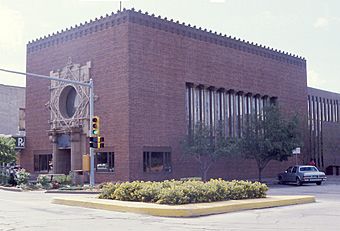Merchants' National Bank facts for kids
|
Merchants' National Bank
|
|
|
U.S. Historic district
Contributing property |
|

Merchants' National Bank
|
|
| Location | 833 Fourth Avenue, Grinnell, Iowa |
|---|---|
| Built | 1914 |
| Architect | Louis Sullivan; Stewart-Robison-Laffan |
| Architectural style | Late 19th And Early 20th Century American Movements |
| Part of | Grinnell Historic Commercial District (ID91000384) |
| NRHP reference No. | 76000804 |
Quick facts for kids Significant dates |
|
| Added to NRHP | January 7, 1976 |
| Designated CP | January 7, 1976 |
The Merchants' National Bank building, built in 1914, is a special old building in Grinnell, Iowa. It's famous because it was designed by a very important architect named Louis Sullivan. He designed several small banks across the Midwest between 1909 and 1919.
This bank building is made of different shades of brick, from dark blue-black to golden brown. This mix gives the building a unique reddish-brown look. Because of its amazing design, it was named a National Historic Landmark in 1976. This means it's a place recognized as important to the history of the United States.
Contents
Discovering the Bank's Unique Design
The Merchants' National Bank first opened its doors on January 1, 1915. On the same day, another bank designed by Louis Sullivan, the Purdue State Bank in Indiana, also opened.
The building itself is shaped like a simple box. However, its front side is truly magnificent, and one of its other sides has many windows.
Even though this bank is smaller than some of Sullivan's other famous banks, like the one in Owatonna or Cedar Rapids, it still looks very grand. This is partly because of a giant, decorative carving called a cartouche that goes around a round window on the front. Inside, the bank gets light from colorful stained-glass windows and a bright skylight that covers most of the ceiling.
Louis Sullivan often used unique animal figures in his designs. At the Merchants' Bank, you can see special, winged lion-like creatures as decorations. These are some of the very few animal figures Sullivan used in his buildings.
Some of the detailed plans and designs for the decorations were created by Sullivan's assistant, Parker N. Berry. Sadly, he passed away shortly after due to the 1918 Spanish flu outbreak.
Changes Over Time
In the 1970s or early 1980s, some trees were planted in front of the bank as part of a city project. Many people thought this was a strange idea because the growing trees would eventually hide the beautiful front of the building. Pictures taken in 1985 show these trees. Luckily, these trees were removed by 2013, allowing everyone to see the bank's design clearly again.
Around 2007, the city of Grinnell updated its downtown sidewalks and streets. They added special planters at the corners of the intersections, which also have the "Jewelbox" design carved into them.
Between 2008 and 2009, one of the decorative lions in front of the building was damaged. Both lions have since been replaced, keeping the bank's original look.
Other Louis Sullivan "Jewel Boxes"
Louis Sullivan designed several other small banks that are sometimes called "jewel boxes" because of their unique and beautiful designs. Here are a few examples:
- Farmers and Merchants Bank, Columbus, Wisconsin (1919)
- Henry Adams Building, Algona, Iowa (1913)
- Home Building Association Company, Newark, Ohio (1914)
- National Farmer's Bank, Owatonna, Minnesota (1908)
- People's Federal Savings and Loan Association, Sidney, Ohio (1918)
- Peoples Savings Bank, Cedar Rapids, Iowa (1912)
- Purdue State Bank, West Lafayette, Indiana (1914)
Images for kids









